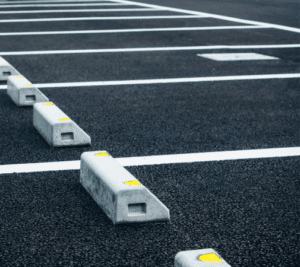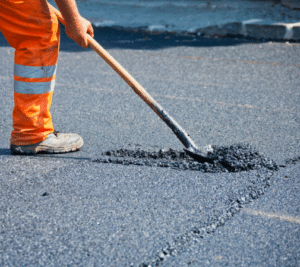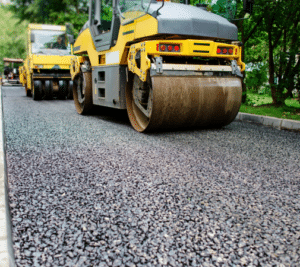Your driveway is one of the first things people see when they visit your home. It’s important to maintain it and keep it looking good. But when it comes to maintenance, what’s the best way to fix cracks and keep your driveway looking great? Is it a slurry seal or a crack seal?
If you need clarification on the difference between slurry seal vs crack seal, don’t worry. In this article, we’ll break down the differences between the two methods and help you decide which is best for your driveway.
Whether you have a small crack or a more significant problem, we’ll provide you with all the information you need to make an informed decision. So, let’s dive in and learn more!
What Is A Driveway Slurry Seal?
A driveway slurry seal is a surface treatment that involves the application of a mixture of asphalt emulsion, aggregate, and often additives directly to a driveway. This treatment aims to protect the underlying pavement from damage and deterioration due to weathering and traffic wear. Slurry seals also help reduce cracking and improve skid resistance, making it safer for vehicle travel.
Slurry Seal Application Process
1. Clean the driveway to ensure it’s free of debris and dirt.
2. Apply a tack coat to create a better bond between the existing pavement and the slurry material.
3. Mix the slurry material in a tank or truck-mounted mixer according to the manufacturer’s instructions.
4. Spread the slurry onto the surface using a squeegee, broom, or specialized sprayer.
5. Press and compact the slurry into the pavement surface using a roller.
6. Allow the slurry seal to dry for several hours before allowing traffic onto it.
What Is A Driveway Crack Seal?
A driveway crack seal is a kind of treatment that helps protect asphalt from damage due to weathering and traffic wear. This type of treatment involves the application of a hot rubberized asphalt material directly into cracks in the driveway surface. This method helps protect against further cracking and improves skid resistance, making it safer for vehicle travel.
Crack Seal Application Process
1. Clean the crack by removing debris, dirt, and loose material with a wire brush or vacuum.
2. Apply a tack coat to create a better bond between the existing pavement and the crack seal material.
3. Use a caulking gun to fill the crack with hot rubberized asphalt material.
4. Use a trowel or putty knife to smooth out and press the material into place.
5. Allow the crack seal to dry for several hours before allowing traffic onto it.
Slurry Seal vs Crack Seal: Compare & Contrast
Slurry Seal:
– A mixture of asphalt emulsion, fine aggregate, and water that is applied to an existing pavement surface.
– Used to extend the life of a pavement by sealing the surface and filling in small cracks and voids.
– Can be used on various surfaces, including roads, parking lots, and airport runways.
– Has a thicker consistency than a crack seal and is applied uniformly over the entire surface.
– Provides a smooth, skid-resistant surface that improves traction and reduces the risk of accidents.
– Can last up to 7 years with proper maintenance.
Crack Seal:
– A flexible material, such as rubberized asphalt or silicone, that is used to fill in small cracks in a pavement surface.
– Used to prevent water from seeping into the pavement and causing further damage.
– Can be used on various surfaces, including roads, parking lots, and airport runways.
– Has a thinner consistency than slurry seal and is applied only to the cracks in the pavement.
– Provides a temporary fix to prevent further damage and extend the life of the pavement.
– Can last up to 3-5 years with proper maintenance.
Both:
– Used to extend the life of a pavement surface.
– Can be applied to a variety of surfaces.
– Require proper maintenance to ensure longevity.
– Can improve the safety of a pavement surface.
Is Slurry Seal Or Crack Seal Better?
Now that you know the pros and cons of each process, you may wonder which is better for your driveway.
The answer to this question largely depends on your pavement’s condition. If you have a lot of cracks and voids in your pavement, then a slurry seal would be the better choice because it fills in these areas and provides a smoother surface. However, if you only have more minor cracks that you need to fill in, then a crack seal may be a better option as it provides an effective temporary fix.
However, if your asphalt surfaces require more extensive repairs, there may be better options than these. In these cases, opting for an asphalt overlay or resurfacing treatment is best. Asphalt overlays are used to restore and replace the top layer of an existing pavement surface. This treatment can help create a smoother and sturdier surface and improve skid resistance. Resurfacing treatments are similar to overlays but involve removing the entire top layer of an existing pavement surface and replacing it with a new one.
Keeping your pavement in good condition is essential regardless of your choice. Regular maintenance helps protect against future damage and extends the life of your asphalt surfaces. Scheduling regular inspections can help identify any potential issues early on so that they can be addressed before they become more significant problems. Additionally, proper maintenance practices like prompt repairs, seal coating, and crack filling can help keep your asphalt surfaces looking and performing their best for years to come.
If you’re looking for an easy and effective way to extend the life of your driveway, then look no further than Saguaro Asphalt’s driveway repair services. Our experienced team of professionals can provide a tailored solution to fit your needs and budget. Contact us today to learn more about how our services can help protect your pavement from damage and keep it looking its best for years.



